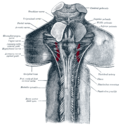| Superior cerebellar peduncle | |
|---|---|
 Sagittal section of the cerebellum, near the junction of the vermis with the hemisphere. (Superior peduncle labeled at upper right.) | |
 Dissection showing the projection fibers of the cerebellum. (Superior peduncle labeled at center top.) | |
| Details | |
| Identifiers | |
| Latin | pedunculus cerebellaris superior |
| NeuroNames | 833 |
| NeuroLex ID | birnlex_1711 |
| TA98 | A14.1.05.006 A14.1.07.417 A14.1.08.678 A14.1.06.009 A14.1.06.216 |
| TA2 | 5846 |
| FMA | 72495 |
| Anatomical terms of neuroanatomy | |
In the human brain, the superior cerebellar peduncle (brachium conjunctivum) is one of the three paired cerebellar peduncles of bundled fibers that connect the cerebellum to the brainstem. The superior cerebellar peduncle connects to the midbrain. It consists mainly of efferent fibers, the cerebellothalamic tract that runs from a cerebellar hemisphere to the contralateral thalamus, and the cerebellorubral tract that runs from a cerebellar hemisphere to the red nucleus. It also contains afferent tracts, most prominent of which is the ventral spinocerebellar tract. Other afferent tracts are the ventral trigeminal tract, tectocerebellar fibers, and noradrenergic fibers from the locus coeruleus. The superior peduncle emerges from the upper and medial parts of the white matter of each cerebellar hemisphere[ citation needed ] and is placed under cover of the upper part of the cerebellum.






